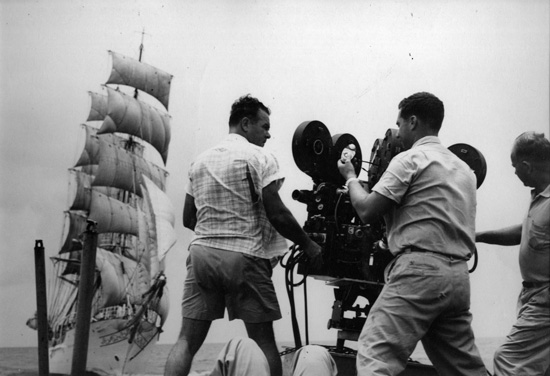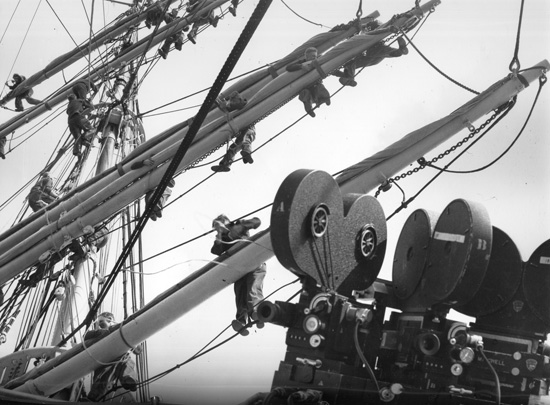Cinemiracle Operating Information for Handling Film | Read more at in70mm.com The 70mm Newsletter |
| Written by: R. H. McCullough. Prepared for in70mm.com by: Anders M. Olsson (Sweden). | Date: 16.10.2017 |
 Filming
the
Christian Radich under sail. Dick Pietschman Collection Filming
the
Christian Radich under sail. Dick Pietschman Collection
Dear Mr. Projectionist: Cinemiracle projection is a highly technical process. The Cinemiracle projection and sound equipment you are operating is costly and is of special design. Considerable thought and study have been given to the handling of the large 8,000 feet film reels used in our Cinemiracle production. Being a projectionist and engineer myself, I am well acquainted with the total weight of a full reel of Cinemiracle film. This is why the Cinemiracle feed reel is on the floor and the rewind equipment is as close to the floor as possible. The cost of a Cinemiracle film print is over six times as much as a standard 35 m.m. film feature print. Great care must be exercised in handling Cinemiracle film. First, you have three perfectly synchronized film prints and should a break occur and mutilation result, you have to add whatever is removed with blank film to keep it in synchronization. This is why it is important that you inspect the Cinemiracle film in your possession after each showing. Make positively sure there are no poor film splices or torn sprocket perforations. Inspect your film thoroughly after or before each performance. You will notice we employ butt joints and use clear Scotch tape for splicing our film, instead of overlapping. Should a bad splice be noticeable, the Scotch tape can be removed easily and replaced without cutting out a frame. If any part of the film is torn, even at an angle, the perforated sprocket hole tape supplied you can be used for placing the torn pieces together. We apply this Scotch tape to each side of the film. These splices pass through our projectors without any interference. It is very important that all the equipment is clean and in good operating condition at all times. We use a very light gauge aluminum film reel. When transporting between the storage cabinets and the rewind to the projectors, may we suggest you use the finger inserts in the 8-inch hub part of the reel for lifting. All reels have to run true, otherwise the scraping of the film on the sides of the reel will cause serious damage to the edges of the film. After threading the Cinemiracle projector, make sure you are in frame at the aperture and that your film is threaded properly over the sprockets, and that all idlers are in their correct position. All projectionists employed on the Cinemiracle shift must check each other after threading. Be positively sure everything is in order before starting the performance. |
More in 70mm reading: "Windjammer" in Cinemiracle Sales Manual For Louis De Rochemont's Windjammer Internet link: |
 Filming
the
Christian Radich with cadets in the masts working with the sail. Dick Pietschman Collection Filming
the
Christian Radich with cadets in the masts working with the sail. Dick Pietschman Collection
The feed reel gear box assembly includes a certain amount of torque and is also equipped with a spring friction disc. This tension should be adjusted sufficiently to avoid free wheeling, otherwise snapping or breaking of the film will occur. Your take-up assembly is driven by a Bodine torque motor. This torque is adequately adjusted in our machine shop and tested before shipment is made. The torque is governed by a 4 microfarad condenser and is capable of taking up the full 8,000 feet of film without any difficulty. Should the take-up pulling power become weak, first look for a loose coupling between the torque motor and in the gear box shaft, then check the condenser. The complete take-up and feed gear assembly can be removed; first remove the feed magazine by removing the supporting screws, then loosen the four supporting bolts and disconnect the torque motor conductors. No trouble has been encountered thus far with this assembly. A complete spare gear box unit with a torque motor is provided in case of an emergency. The magazine units are properly lined with the feed film chute and the projector mechanism lower take-up sprocket during the initial installation. However please check the alinement during your routine inspection. As stated previously, the care of Cinemiracle film is very important. During inspection and rewinding, examine the film sprocket perforations. Make sure they are not damaged or checked on the pull down side. If they do indicate strain, locate the trouble immediately. It is possible the gate tension shoes may have excessive tension. The tension pressure should be only sufficient to keep the film from jumping during operation. Any excessive tension will cause wear on the film sprocket perforations. Our film speed is 146.25 feet per minute. When inspecting film, check for emulsion scratches. If anything serious happens to the Cinemiracle film print, get in touch with R. H. McCullough, at National Theatres Amusement Company, 1837 South Vermont Avenue, Los Angeles, California, telephone Republic 1-4111. Sincerely, R. H. McCullough |
|
| Go: back - top - back issues - news index Updated 22-01-25 |
